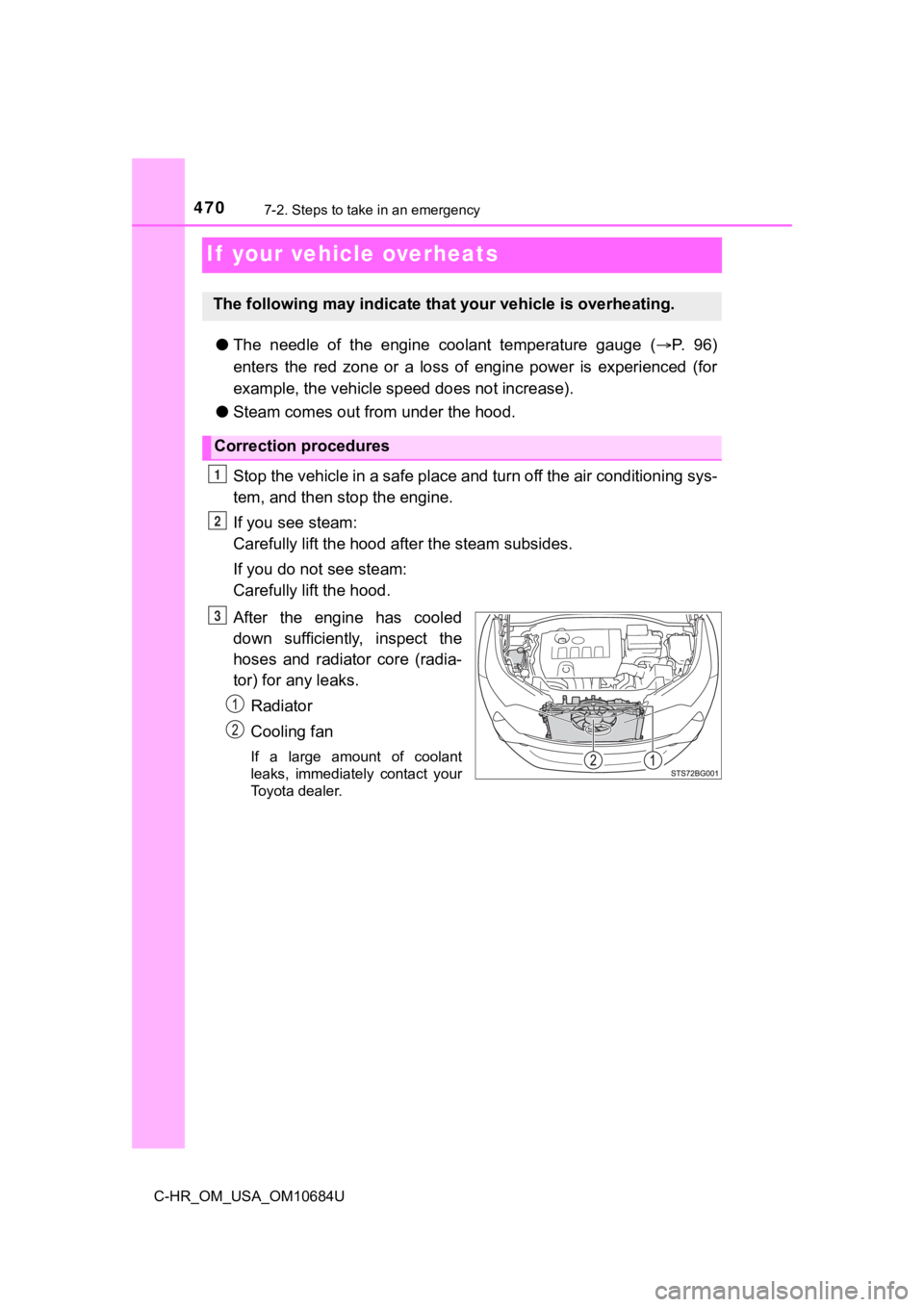2021 TOYOTA C-HR air condition
[x] Cancel search: air conditionPage 432 of 548

4327-2. Steps to take in an emergency
C-HR_OM_USA_OM10684U
If you think something is wrong
●Fluid leaks un der the vehicle.
(Water dripping from the air conditioning a fter use is normal.)
● Flat-looking tires or uneven tire wear
● Engine coolant temperature gauge needle continually points high er
than normal.
● Changes in exhaust sound
● Excessive tire squeal when cornering
● Strange noises related to the suspension system
● Pinging or other noises related to the engine
● Engine misses, stumbli ng or running roughly
● Appreciable loss of power
● Vehicle pulls heavily to one side when braking
● Vehicle pulls heavily to one s ide when driving on a level road
● Loss of brake effectiveness, spongy feeling, pedal almost touch es
the floor
If you notice any of the followi ng symptoms, your vehicle proba -
bly needs adjustment or repair. Contact your Toyota dealer as
soon as possible.
Visible symptoms
Audible symptoms
Operational symptoms
Page 440 of 548

4407-2. Steps to take in an emergency
C-HR_OM_USA_OM10684U■
When the tire pressure warning light comes on
Inspect the appearance of the ti
re to check that the tire is not punctured.
If the tire is punctured: P. 449
If the tire is not punctured:
Carry out the following procedure after the tire temperature has lowered
sufficiently.
●Check the tire inflation pressure and adjust to the appropriate level.
●If the warning light does not go out even after several minutes , check
that the tire inflation pressure is at the specified level and carry out ini-
tialization. ( P. 3 7 8 )
The warning light may come on again if the above operations are con-
ducted without first allowing t he tire temperature to lower suf ficiently.
■The tire pressure warning light may come on due to natural caus es
The tire pressure warning light may come on due to natural caus es such
as natural air leaks and tire inflation pressure changes caused by tem-
perature. In this case, adjusting the tire inflation pressure w ill turn off the
warning light (afte r a few minutes).
■When a tire is replace d with a spare tire
The compact spare tire is not equipped with a tire pressure war ning valve
and transmitter. If a tire goes flat, the tire pressure warning light will not
turn off even though the flat tire has been replaced with the s pare tire.
Replace the spare tire with the repaired tire and adjust the ti re inflation
pressure. The tire pressure war ning light will go off after a few minutes.
■Conditions that the tire pressure warning system may not functi on
properly
P. 3 8 1
■If the tire pressure warning light frequently comes on after bl inking
for 1 minute
If the tire pressure warning light frequently comes on after bl inking for
1 minute when the engine switch is turned to the “ON” position (vehicles
without smart key system) or IGNITION ON mode (vehicles with sm art
key system), have it checked by your Toyota dealer.
■Warning buzzer
In some cases, the buzzer may not be heard because of noisy pla ce or an
audio sound.
Page 467 of 548

4677-2. Steps to take in an emergency
7
When trouble arises
C-HR_OM_USA_OM10684U
Vehicles without a smart key system:
Maintain the engine speed of the second vehicle and turn the
engine switch to the “ON” position, then start the vehicle’s engine.
Vehicles with a smart key system:
Maintain the engine speed of the second vehicle and turn the
engine switch to IGNITION ON m ode, then start the vehicle’s
engine.
Once the vehicle’s engine has st arted, remove the jumper cables in
the exact reverse order from which they were connected.
To install the engine cover, conduct the removal procedure in
reverse. After installing, check that the fixed pins are inserted
securely.
Once the engine starts, have the vehicle inspected at your Toyota
dealer as soon as possible.
■ Starting the engine when t he battery is discharged
The engine cannot be started by push-starting.
■ To prevent battery discharge
●Turn off the headlights and the air conditioning system while the engine is
stopped.
● Turn off any unnecessary electrical components when the vehicle is running
at a low speed for an extended period, such as in heavy traffic .
■ Charging the battery
The electricity stored in the battery will discharge gradually even when the
vehicle is not in use, due to natural discharge and the draining effects of cer-
tain electrical appliances. If the vehicle is left for a long t ime, the battery may
discharge, and the engine may be unable to start. (The battery recharges
automatically during driving.)
■ Precautions when the battery is discharged (vehicles with a sma rt key
system)
● In some cases, it may not be possible to unlock the doors using the smart
entry & start system when the battery is discharged. Use the wi reless
remote control or the mechanical key to lock or unlock the door s.
● The engine may not start on the first attempt after the battery has recharged
but will start normally after the second attempt. This is not a malfunction.
● The engine switch mode is memorized by the vehicle. When the ba ttery is
reconnected, the system will return to the mode it was in befor e the battery
was discharged. Before disconnecting the battery, turn the engine switch off.
If you are unsure what mode the engine switch was in before the battery dis-
charged, be especially careful when reconnecting the battery.
6
7
8
Page 470 of 548

4707-2. Steps to take in an emergency
C-HR_OM_USA_OM10684U
If your vehicle overheats
●The needle of the engine coolant temperature gauge ( P. 9 6 )
enters the red zone or a loss of engine power is experienced (f or
example, the vehicle speed does not increase).
● Steam comes out f rom under the hood.
Stop the vehicle in a safe place and turn off the air condition ing sys-
tem, and then stop the engine.
If you see steam:
Carefully lift the hood after the steam subsides.
If you do not see steam:
Carefully lift the hood.
After the engine has cooled
down sufficiently, inspect the
hoses and radiator core (radia-
tor) for any leaks. Radiator
Cooling fan
If a large amount of coolant
leaks, immediately contact your
Toyota dealer.
The following may indicate that your vehicle is overheating.
Correction procedures
1
2
3
Page 471 of 548

4717-2. Steps to take in an emergency
7
When trouble arises
C-HR_OM_USA_OM10684U
The coolant level is satisfactory
if it is between the “FULL” and
“LOW” lines on the reservoir.Reservoir
“FULL” line
“LOW” line
Add coolant if necessary.
Water can be used in an emer-
gency if coolant is unavailable.
Start the engine and turn the ai r conditioning system on to check
that the radiator cooling fan operates and to check for coolant leaks
from the radiator or hoses.
The fan operates when the air conditioning system is turned on immedi-
ately after a cold start. Confirm that the fan is operating by checking the fan
sound and air flow. If it is difficult to check these, turn the air conditioning
system on and off repeatedly.
(The fan may not operate in freezing temperatures.)
If the fan is not operating:
Stop the engine immediately and contact your Toyota dealer.
If the fan is operating:
Have the vehicle ins pected at the nearest Toyota dealer.
4
5
6
7
Page 494 of 548

4948-1. Specifications
C-HR_OM_USA_OM10684U
Glossary of tire terminology
Tire related termMeaning
Cold tire inflation pres-
sure
Tire pressure when the vehicle has been
parked for three hours or more, or has not
been driven more than 1 mile or 1.5 km under
that condition
Maximum inflation
pressureThe maximum cold inflated pressure to which
a tire may be inflated, shown on the sidewall
of the tire
Recommended infla-
tion pressureCold tire inflation pressure recommended by a
manufacturer
Accessory weight
The combined weight (in excess of those stan-
dard items which may be replaced) of auto-
matic transmission, power steering, power
brakes, power windows, power seats, radio
and heater, to the extent that these items are
available as factory-installed equipment
(whether installed or not)
Curb weight
The weight of a motor vehicle with standard
equipment, including the maximum capacity of
fuel, oil and coolant, and if so equipped, air
conditioning and additional weight optional
engine
Maximum loaded vehi-
cle weight
The sum of:
(a) Curb weight
(b) Accessory weight
(c) Vehicle capacity weight
(d) Production options weight
Normal occupant
weight150 lb. (68 kg) times the number of occupants
specified in the second column of Table 1
*
that follows
Occupant distributionDistribution of occupants in a vehicle as speci-
fied in the third column of Table 1
* below
Page 509 of 548

5098-2. Customization
8
Vehicle specifications
C-HR_OM_USA_OM10684U■
RCTA (Rear Cross Traffic Alert)* (
P. 2 9 2 )
*: If equipped
■
Air conditioning system ( P. 312)
FunctionDefault settingCustomized
setting
RCTA (Rear Cross
Traffic Alert) functionOnOffO——
Buzzer volumeLevel2Level1O——Level3
FunctionDefault settingCustomized
setting
A/C auto switch oper-
ationAutoManual—OO
Page 532 of 548

532Alphabetical index
C-HR_OM_USA_OM10684U
Alphabetical index
A/C ............................................ 312Air conditioning filter ............. 393
ABS (Anti-lock Brake System)...... 300
Warning light ......................... 435
ACA (Active Cornering Assist) ..... 300
Active Cornering Assist
(ACA) ...................................... 300
Air conditioning filter .............. 393
Air conditioning system.......... 312 Air conditioning filter ............. 393
Airbags ....................................... 34 Airbag operating conditions .... 43
Airbag preca utions for
your child .............................. 37
Correct driving posture ........... 26
Curtain shield airbag
operating conditions ............. 44
Curtain shield airbag
precautions ........................... 37
General airbag precautions .... 37
Locations of airbags................ 34
Modification and disposal of airbags ............... 42
Side airbag operating conditions ............................. 44
Side airbag precautions .......... 37
Side and curtain shield airbags operating conditions ............. 44
Side and curtain shield airbags precautions ........................... 37
SRS airbags............................ 34
SRS warning light ................. 435 Anchor brackets ........................ 59
Anti-lock Brake System
(ABS) ...................................... 300 Warning light......................... 435
Assist grips .............................. 338
Audio input
*
Audio remote control switches*
Audio system*
Automatic High Beam ............. 209
Automatic light control system.................................... 204
Auxiliary boxes ........................ 331
A